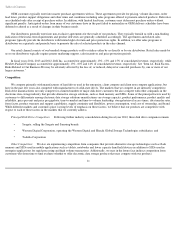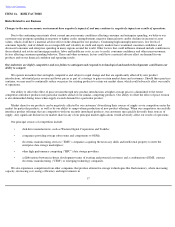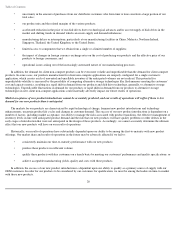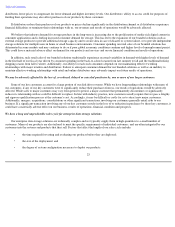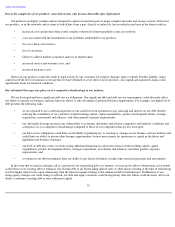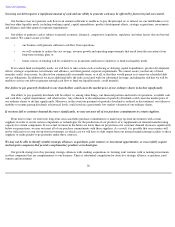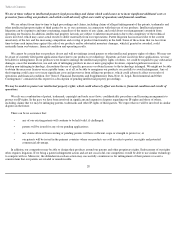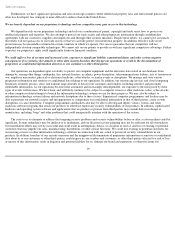Seagate 2013 Annual Report Download - page 24
Download and view the complete annual report
Please find page 24 of the 2013 Seagate annual report below. You can navigate through the pages in the report by either clicking on the pages listed below, or by using the keyword search tool below to find specific information within the annual report.
Table of Contents
Once a product is accepted, any failure or delay in the qualification process or a requirement that we requalify can result in our losing sales to
that customer until new products are introduced. The limited number of high-volume OEMs magnifies the effect of missing a product
qualification opportunity. These risks are further magnified because we expect competitive pressures to result in declining sales, eroding prices,
and declining gross margins on our current generation products. If the delivery of our products is delayed, our OEM customers may use our
competitors' products to meet their production requirements. We cannot assure that we will be among the leaders in time-to-market with new
products or that we will be able to successfully qualify new products with our customers in the future.
We face the related risk that consumers and businesses may wait to make their purchases if they want to buy a new product that has been
shipped or announced but not yet released. If this were to occur, we may be unable to sell our existing inventory of products that may be less
efficient and cost effective compared to new products. As a result, even if we are among the first-to-maturity with a given product, subsequent
introductions or announcements by our competitors of new products could cause us to lose revenue and not achieve a positive return on our
investment in existing products and inventory.
If we cannot successfully deliver competitive products, our future results of operations may be adversely affected.
If we experience shortages or delays in the receipt of, or cost increases in, critical components, equipment or raw materials necessary to
manufacture our products, we may suffer lower operating margins, production delays and other material adverse effects.
The cost, quality and supply of components, subassemblies, certain equipment and raw materials used to manufacture our products and key
components like recording media and heads are critical to our success. The equipment we use to manufacture our products and components is
frequently custom made and comes from a few suppliers and the lead times required to obtain manufacturing equipment can be significant.
Particularly important for our products include read/write heads, aluminum or glass substrates for recording media, ASICs, spindle motors,
printed circuit boards, and suspension assemblies.
We rely on sole suppliers or a limited number of suppliers for some of these components that we do not manufacture, including aluminum
and glass substrates, read/write heads, ASICs, spindle motors, printed circuit boards, and suspension assemblies. Many of such component
suppliers are geographically concentrated, in particular, in Thailand, which makes our supply chain more vulnerable to regional disruptions such
as the severe flooding in Thailand in October 2011, which had a material impact on the production and availability of many components. If our
vendors for these components are unable to meet our cost, quality, and supply requirements, we could experience a shortage in supply or an
increase in production costs, which would adversely affect our results of operations.
Certain rare earth elements are critical in the manufacture of our products. We purchase components that contain rare earth elements from a
number of countries, including the People's Republic of China. We cannot predict whether any nation will impose regulations, quotas or
embargoes upon the rare earth elements incorporated into our products that would restrict the worldwide supply of such metals or increase their
cost. We have experienced increased costs and production delays when we were unable to obtain the necessary equipment or sufficient quantities
of some components, and/or have been forced to pay higher prices or make volume purchase commitments or advance deposits for some
components, equipment or raw materials that were in short supply in the industry in general. If any major supplier were to restrict the supply
available to us or increase the cost of the rare earth elements used in our products, we could experience a shortage in supply or an increase in
production costs, which would adversely affect our results of operations.
Consolidation among component manufacturers has resulted and may continue to result in some component manufacturers exiting the
industry or not making sufficient investments in research to develop new components.
21


